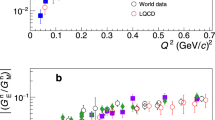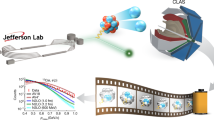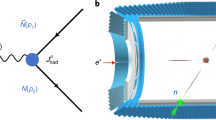Abstract
The discrete quantum properties of matter are manifest in a variety of phenomena. Any particle that is trapped in a sufficiently deep and wide potential well is settled in quantum bound states. For example, the existence of quantum states of electrons in an electromagnetic field is responsible for the structure of atoms16, and quantum states of nucleons in a strong nuclear field give rise to the structure of atomic nuclei17. In an analogous way, the gravitational field should lead to the formation of quantum states. But the gravitational force is extremely weak compared to the electromagnetic and nuclear force, so the observation of quantum states of matter in a gravitational field is extremely challenging. Because of their charge neutrality and long lifetime, neutrons are promising candidates with which to observe such an effect. Here we report experimental evidence for gravitational quantum bound states of neutrons. The particles are allowed to fall towards a horizontal mirror which, together with the Earth's gravitational field, provides the necessary confining potential well. Under such conditions, the falling neutrons do not move continuously along the vertical direction, but rather jump from one height to another, as predicted by quantum theory1,2,3.
This is a preview of subscription content, access via your institution
Access options
Subscribe to this journal
Receive 51 print issues and online access
$199.00 per year
only $3.90 per issue
Buy this article
- Purchase on Springer Link
- Instant access to full article PDF
Prices may be subject to local taxes which are calculated during checkout




Similar content being viewed by others
References
Luschikov, V. I. & Frank, A. I. Quantum effects occurring when ultracold neutrons are stored on a plane. JETP Lett. 28, 559–561 (1978).
Nesvizhevsky, V. V. et al. Search for quantum states of the neutron in a gravitational field: gravitational levels. Nucl. Instrum. Methods Phys. Res. 440, 754–759 (2000).
Nesvizhevsky, V. V. et al. in ILL Annual Report (eds Cicognani, G. & Vettier, Ch.) 64–65 (Institute Laue-Langevin, Grenoble, 2000).
Landau, L. D. & Lifshitz, E. M. Quantum Mechanics 164–196 (Pergamon, Oxford, 1976).
Flügge, S. Practical Quantum Mechanics (Mir, Moscow, 1974).
Colella, R. A., Overhauser, W. & Werner, W. A. Observation of gravitationally induced quantum interference. Phys. Rev. Lett. 34, 1472–1474 (1975).
Baryshevskii, V. G., Chrerepitza, S. V. & Frank, A. I. Neutron spin interferometry. Phys. Lett. A 153, 299–302 (1991).
Frank, A. I. Modern optics of long-wavelength neutrons. Sov. Phys. Usp. 34, 980–987 (1991).
Felber, J., Gähler, R., Rauch, C. & Golub, R. Matter waves at a vibrating surface: Transition from quantum-mechanical to classical behavior. Phys. Rev. A 53, 319–328 (1996).
Peters, A., Chung, K. Y. & Chu, S. Measurement of gravitational acceleration by dropping atoms. Nature 400, 849–852 (1999).
Luschikov, V. I., Pokotilovsky, Yu. N., Strelkov, A. V. & Shapiro, F. L. Observation of ultracold neutrons. JETP Lett. 9, 23–26 (1969).
Steyerl, A. Measurement of total cross sections for very slow neutrons with velocities from 100m/s to 5m/s. Phys. Lett. B 29, 33–35 (1969).
Ignatovich, V. K. The Physics of Ultracold Neutrons (Clarendon, Oxford, 1990).
Golub, R., Richardson, D. J. & Lamoreux, S. K. Ultracold Neutrons (Higler, Bristol, 1991).
Steyerl, A. & Malik, S. S. Sources of ultracold neutrons. Nucl. Instrum. Methods Phys. Res. A 284, 200–207 (1989).
Born, M. Atomic Physics (Blackie & Son, London, 1969).
Bohr, A. & Mottelson, B. R. Nuclear Structure (Benjamin, New York, 1969).
Acknowledgements
We are grateful to our colleagues who were interested in this research and contributed to its development, in particular K. Ben-Saidane, D. Berruyer, Th. Brenner, J. Butterworth, D. Dubbers, P. Geltenbort, T. M. Kuzmina, A. J. Leadbetter, B. G. Peskov, S. V. Pinaev, K. Protasov, I. A. Snigireva, S. M. Soloviev and A. Voronin. The work was supported by INTAS.
Author information
Authors and Affiliations
Corresponding author
Ethics declarations
Competing interests
The authors declare no competing financial interests.
Rights and permissions
About this article
Cite this article
Nesvizhevsky, V., Börner, H., Petukhov, A. et al. Quantum states of neutrons in the Earth's gravitational field. Nature 415, 297–299 (2002). https://doi.org/10.1038/415297a
Received:
Accepted:
Issue Date:
DOI: https://doi.org/10.1038/415297a
This article is cited by
-
Adaptable platform for trapped cold electrons, hydrogen and lithium anions and cations
Communications Physics (2023)
-
Relaxation to Quantum Equilibrium and the Born Rule in Nelson’s Stochastic Dynamics
Foundations of Physics (2023)
-
Tests of fundamental quantum mechanics and dark interactions with low-energy neutrons
Nature Reviews Physics (2021)
-
Non-local imprints of gravity on quantum theory
General Relativity and Gravitation (2021)
-
Retroreflection and diffraction of a Bose–Einstein condensate by evanescent standing wave potential
Scientific Reports (2020)
Comments
By submitting a comment you agree to abide by our Terms and Community Guidelines. If you find something abusive or that does not comply with our terms or guidelines please flag it as inappropriate.



